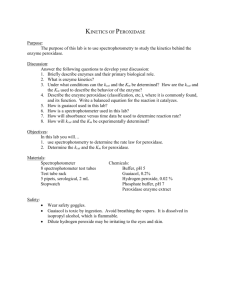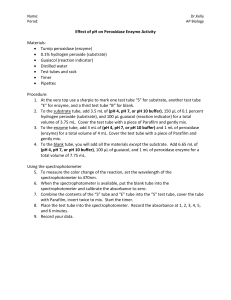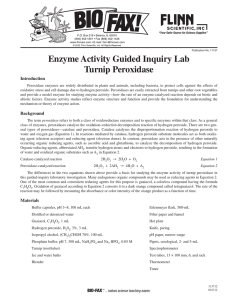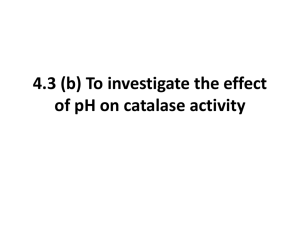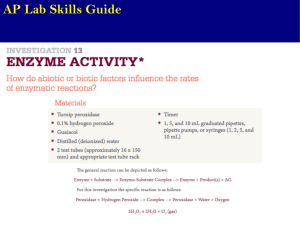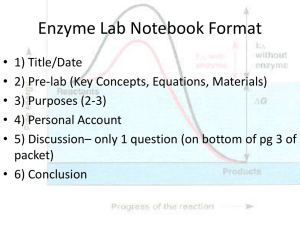Enzyme Activity Lab 13
advertisement
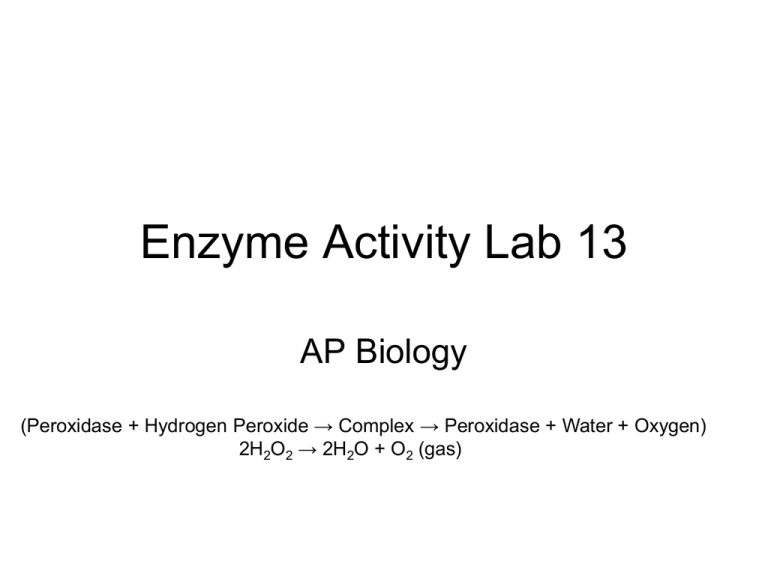
Enzyme Activity Lab 13 AP Biology (Peroxidase + Hydrogen Peroxide → Complex → Peroxidase + Water + Oxygen) 2H2O2 → 2H2O + O2 (gas) Learning Objectives • • The student is able to design a plan for collecting data to show that all biological systems are affected by complex biotic and abiotic interactions (2D1 & SP 4.2, SP 7.2). • • The student is able to use models to predict and justify that changes in the subcomponents of a biological polymer affect the functionality of the molecule (4A1 • & SP 6.1, SP 6.4). • • The student is able to analyze data to identify how molecular interactions affect structure and function (4B1 & SP 5.1). • ■ Basic background information • • • • • Basic protein structure • The concept of induced fit • The role of enzymes • That structure, function, and environment are all required for maximal function of enzymatic reactions 2H2O2 → 2H2O + O2 (gas) • Peroxidase is an enzyme that breaks down peroxides, such as hydrogen peroxide, and is produced by most cells in their peroxisomes. Peroxide is a toxic byproduct of aerobic metabolism. Various factors — abiotic and biotic — could have a major influence on the efficiency of this reaction. Label carefully • Gather all materials • Plan your procedure and know what you are doing before you start. Do a mock run… • There is timing involved, so be prepared to start the timer as soon as you mix the materials. • Make data charts ahead of time so you have a place to put your results. So, what is this lab about? • Turnip peroxidase is the enzyme that catalyzes the reaction that breaks down hydrogen peroxide into water and oxygen. guaiacol • We can “see” the reaction because we are adding guaiacol, an indicator of oxygen due to a color change that occurs in its presence. The more oxygen the deeper the brown the color becomes. The compound guaiacol has a high affinity for oxygen, and in solution,it binds instantly with oxygen to form tetraguaiacol, which is brownish in color. The greater the amount of oxygen produced, the darker brown the solution will become. • We can qualitatively or quantitatively measure the color change after allowing the reaction to occur. • A color palette is prepared by placing different amounts of enzyme and substrate mixture with distilled water so that the final percent of the solutions varies by 10% in each of the 11 test tubes prepared. • This will provide a way to view the different colors that can be seen for the different amounts of oxygen released at maximum production. It will be used for comparison for the other reactions. • Baseline is a universal term for most chemical reactions. In this investigation, the term is used to establish a standard for a reaction. Thus, when manipulating components of a reaction (in this case, substrate or enzyme) you have a reference point to help understand what occurred in the reaction. The baseline may vary with different scenarios pertinent to the design of the experiment, such as altering the environment in which the reaction occurs. In this scenario, different conditions can be compared, and the effects of changing an environmental variable (e.g., pH) can be determined. Color palette • Rate can have more than one applicable definition because this lab has two major options of approach, i.e., using a color palette and/or a spectrophotometer to measure percent of light absorbance. When using a color palette to compare the change in a reaction, you can infer increase, decrease, or no change in the rate; this inference is usually called the relative rate of the reaction. . Part 1 Baseline materials+ labeling 1. E= enzyme the cold, turnip enzyme • label a 2.5 ml syringe to use to measure this. 2. P= product (oxygen) which is shown when guaiacol reacts with it and turns brown • label a 2.5ml syringe to use to measure this 3. NB= buffer pH7 neutral buffer • label a 10ml syringe to use to measure this 4. S= substrate, Hydrogen peroxide • label a 2.5ml syringe to use to measure this • 5. test tube- label SPNB substrate, product, neutral buffer • 6. Test tube- label ENB enzyme, neutral buffer Time minutes 0 1 2 3 4 5 Scale/ number B ENB 3ml NB neutral Buffer pH 7 1ml E= Enzyme turnip peroxidase A SPNB 1ml NB neutral Buffer pH 7 1ml P = guaiacol 2ml Substrate hydrogen peroxide Cover with parafilm and mix . Use a disposable pipette to transfer tube A to tube B. Cover and mix. Immediately observe by comparing to the color palette and begin timing! Observe every minute for 5 minutes. Calculate the rate for the baseline. Color change/% oxygen over time Time minutes 0 1 2 3 4 5 Scale/ number B ENB 3ml NB neutral Buffer pH 7 1ml E Enzyme turnip peroxidase A SPNB 1ml NB neutral Buffer pH 7 1ml P = guaiacol 2ml Substrate hydrogen peroxide Immediately observe by comparing to the color palette and begin timing! Observe every minute for 5 minutes. Calculate the rate for the baseline. Color change/% oxygen over time Part 2 • This part will test how different pH levels will alter the reaction rates as compared to the baseline. • Gather your materials. Plan your procedure. Put in the correct amounts. Be careful with the buffers! Acids and bases can harm your skin and eyes! • Label the test tubes,Set up your test tubes in pairs. Tubes 1,2,4,9,11,12 1 ml NB neutral buffer 1 ml P=product indicator guaiacol 2 ml S= hydrogen peroxide Tubes 3,5,6,7,8,10 Make a data chart! 1 ml E=turnip peroxidase solution 3 ml buffer of the correct pH for the tube. For example tube 3 use pH 3, tube 5 pH of 5 etc! Tubes 1,2,4,9,11,12 1 ml NB neutral buffer 1 ml P=product indicator guaiacol 2 ml S= hydrogen peroxide Be ready! Tubes 3,5,6,7,8,10 Mix tube 1 with tube 3. Observe at time zero and every minute for 5 minutes! 1 ml E=turnip peroxidase solution 3 ml buffer of the correct pH for the tube. For example tube 3 use pH 3, tube 5 pH of 5 etc! rate • Calculate the rate for each tube. • How much oxygen produced in 5 minutes? • Based on the readings over the 5 minute time period compared to the color change or % of oxygen. • % change over time= rate graph • Rate for each pH Assessment Questions • • • • • #3. If you omitted the enzyme? If you omitted the substrate? If you omitted the indicator? Based on your answer to #4 develop a specific question to test for part 3 of the lab. • Your group must submit an experimental plan for approval. Part 3 • • • • Complete your experiment planning sheet Record your data. Data analysis What conclusion can be drawn from your groups data? • Create a presentation to share your findings
